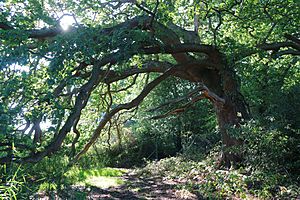Lincegrove and Hackett's Marshes facts for kids
| Site of Special Scientific Interest | |
 |
|
| Area of Search | Hampshire |
|---|---|
| Interest | Biological |
| Area | 37.8 hectares (93 acres) |
| Notification | 1984 |
| Location map | Magic Map |
Lincegrove and Hackett's Marshes is a very special natural area. It covers about 37.8 hectares (that's like 93 acres!). This important place is found on the west side of the River Hamble. This river flows between the cities of Southampton and Fareham in Hampshire, England.
This area is officially known as a biological Site of Special Scientific Interest (SSSI). This means it's protected because of its amazing wildlife. It's also part of even bigger protected areas. These include the Solent and Southampton Water Ramsar site and Special Protection Area. It's also part of the Solent Maritime Special Area of Conservation. A part of this site, called Hackett's Marsh, is also a Local Nature Reserve. It covers about 20.4 hectares (50 acres).
Contents
Lincegrove and Hackett's Marshes: A Special Place
Lincegrove and Hackett's Marshes are one of the best examples of saltmarshes along the south coast of England. A saltmarsh is a type of wetland that is flooded by salty seawater at high tide. It's a unique environment where special plants and animals live.
Protecting Nature: What These Names Mean
These marshes have many important names. Each name means it's protected for different reasons. These protections help keep the area safe for its wildlife.
Site of Special Scientific Interest (SSSI)
A Site of Special Scientific Interest, or SSSI, is a special area in the UK. The government protects these places because they have rare wildlife or important geology. Lincegrove and Hackett's Marshes are an SSSI because of their amazing saltmarsh habitat.
International Protection: Ramsar, SPA, and SAC
Lincegrove and Hackett's Marshes are part of even larger protected areas. These areas are recognized internationally.
- A Ramsar site is a wetland of international importance. These sites are protected under a global agreement.
- A Special Protection Area (SPA) protects wild birds and their habitats. It helps make sure birds have safe places to live and breed.
- A Special Area of Conservation (SAC) protects important habitats and species across Europe.
All these different protections show how valuable Lincegrove and Hackett's Marshes are. They are important for local wildlife and for nature around the world.
Life in the Saltmarsh: A Unique Habitat
Saltmarshes are amazing places where land and sea meet. They are flooded by the tide twice a day. This means the plants and animals living there must be able to handle both salty water and dry land.
What Makes a Saltmarsh Special?
The soil in a saltmarsh is often muddy and full of salt. Only certain plants can grow in these tough conditions. These plants are very important. They help to trap mud and slow down the water. This helps to build up the land over time. Saltmarshes also act like natural sponges. They can soak up water during storms. This helps to protect the land behind them from flooding.
Amazing Plants of Lincegrove and Hackett's Marshes
The plants that grow in saltmarshes are very special. They have adapted to live in salty, wet conditions. Lincegrove and Hackett's Marshes are home to many interesting plants.
Sea Purslane and Common Cordgrass
Two main plants dominate these marshes. They are sea purslane (Halimione portulacoides) and common cordgrass.
- Sea purslane is a shrub with silvery-green leaves. It can handle a lot of salt.
- Common cordgrass is a tall, tough grass. It grows in dense clumps. It helps to stabilize the muddy ground.
Other Cool Plants You Might Find
Besides the main plants, you can find other interesting species here.
- Sea lavender (Limonium vulgare) has pretty purple flowers. It adds a splash of color to the marsh.
- Thrift (Armeria maritima), also known as sea pink, has small, pink, ball-shaped flowers.
- Sea aster looks a bit like a daisy. It has purple petals and a yellow center.
- Sea clubrush is a type of sedge. It grows in wet areas of the marsh.
These plants create a rich habitat. They provide food and shelter for many animals.
Images for kids


